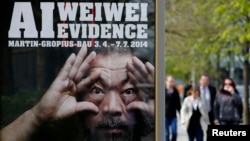BERLIN —
Chinese artist Ai Weiwei's biggest solo show, featuring a reproduction of the white cell where he was held for 81 days by Chinese authorities, was unveiled on Wednesday in Berlin without Ai in attendance because the government still has his passport.
“Ai Weiwei - Evidence” - which sprawls through 18 rooms at the Martin-Gropius-Bau museum - is a deeply political exhibition of his conceptual art. It opens on Thursday, exactly three years after he was arrested and held in detention.
A white bedroom with foam-covered walls and surveillance cameras reproduces his prison cell.
An outspoken critic of the Chinese government's record on free speech and human rights, Ai did not attend the show's news conference as the Chinese government retained his passport after his release.
“I may have a chance to come to the show, I hope this can be possible, but I don't know,” the bearded artist said via video message.
His detention prompted an international outcry and Germany was among those countries that have asked for his release.
“Germany is a place that gives me a lot of support,” said Ai, who was awarded a professorship in absentia at Berlin's University of the Arts in 2011.
German curator Gereon Sievernich, who visited the artist in his studio on the outskirts of Beijing, said Ai created several installations specifically for the show.
“He says he wants to prove the truth,” said Sievernich, in reference to the exhibition's title “Evidence.”
Ai's public comments, activities and art flagrantly defy China's strict controls on the Internet and traditional media.
Weiwei readymades
The Berlin show, which runs until July 7, deals with Ai's detention but also with modernization in China and its perils.
In one of the most striking installations, 6,000 wooden stools gathered from villages across northern China from past centuries are packed into the neo-classical atrium.
They all share the same design but some are painted green, red and yellow, others have narrow seats. All are unique.
“These stools represent a piece of individuality,” Sievernich said, comparing them with mass-manufactured plastic stools. “Today they are vestiges of history.”
Other works reflect on traditional handicrafts, history and modernity but are more playful and inspired by Ai's admiration of the Dadaist and conceptual artist Marcel Duchamp's readymades.
In one work particularly appropriate for car-crazy Germany, Han Dynasty (202 BC-220 AD) vases are covered in metallic paint in the same colors as those used on Mercedes and BMW automobiles.
“Each vase is no longer recognizable as an ancient artifact, yet beneath the thin outer layer the history and complexity of the original remain intact,” the accompanying text reads.
Ai's career has spanned protests for artistic freedom in 1979, provocative works in the 1990s, and a hand in designing the Bird's Nest stadium for the 2008 Beijing Olympics as well as creating “Sunflower Seeds,” a London-based exhibition comprised of 100 million hand-painted porcelain seeds.
“Ai Weiwei - Evidence” - which sprawls through 18 rooms at the Martin-Gropius-Bau museum - is a deeply political exhibition of his conceptual art. It opens on Thursday, exactly three years after he was arrested and held in detention.
A white bedroom with foam-covered walls and surveillance cameras reproduces his prison cell.
An outspoken critic of the Chinese government's record on free speech and human rights, Ai did not attend the show's news conference as the Chinese government retained his passport after his release.
“I may have a chance to come to the show, I hope this can be possible, but I don't know,” the bearded artist said via video message.
His detention prompted an international outcry and Germany was among those countries that have asked for his release.
“Germany is a place that gives me a lot of support,” said Ai, who was awarded a professorship in absentia at Berlin's University of the Arts in 2011.
German curator Gereon Sievernich, who visited the artist in his studio on the outskirts of Beijing, said Ai created several installations specifically for the show.
“He says he wants to prove the truth,” said Sievernich, in reference to the exhibition's title “Evidence.”
Ai's public comments, activities and art flagrantly defy China's strict controls on the Internet and traditional media.
Weiwei readymades
The Berlin show, which runs until July 7, deals with Ai's detention but also with modernization in China and its perils.
In one of the most striking installations, 6,000 wooden stools gathered from villages across northern China from past centuries are packed into the neo-classical atrium.
They all share the same design but some are painted green, red and yellow, others have narrow seats. All are unique.
“These stools represent a piece of individuality,” Sievernich said, comparing them with mass-manufactured plastic stools. “Today they are vestiges of history.”
Other works reflect on traditional handicrafts, history and modernity but are more playful and inspired by Ai's admiration of the Dadaist and conceptual artist Marcel Duchamp's readymades.
In one work particularly appropriate for car-crazy Germany, Han Dynasty (202 BC-220 AD) vases are covered in metallic paint in the same colors as those used on Mercedes and BMW automobiles.
“Each vase is no longer recognizable as an ancient artifact, yet beneath the thin outer layer the history and complexity of the original remain intact,” the accompanying text reads.
Ai's career has spanned protests for artistic freedom in 1979, provocative works in the 1990s, and a hand in designing the Bird's Nest stadium for the 2008 Beijing Olympics as well as creating “Sunflower Seeds,” a London-based exhibition comprised of 100 million hand-painted porcelain seeds.













